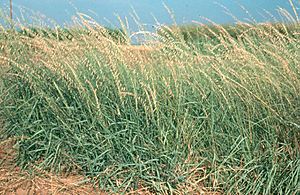Sideoats grama facts for kids
Quick facts for kids Sideoats grama |
|
|---|---|
 |
|
| Scientific classification | |
| Genus: |
Bouteloua
|
| Species: |
curtipendula
|
Sideoats grama (scientific name: Bouteloua curtipendula) is a type of grass. It is a perennial plant, which means it lives for more than two years. This grass is short and grows naturally in prairies. You can find it across the temperate and tropical parts of the Western Hemisphere. Its range stretches from Canada all the way south to Argentina.
The name "curtipendula" comes from Latin words. "Curtus" means "shortened," and "pendulus" means "hanging." This describes how parts of the plant hang down.
Contents
What Sideoats Grama Looks Like
Sideoats grama is a "warm-season" grass. This means it grows best when the weather is warm. Its flowering stems, called culms, can grow from about 30 to 100 centimeters (12 to 39 inches) tall. The leaves grow on opposite sides of the stem, mostly near the bottom. They are light green to blue-green and can be up to 6 millimeters (about 1/4 inch) wide.
The flowers appear in summer and autumn. They grow in compact clusters called spikes. These spikes hang down and are arranged alternately along the top 15 to 25 centimeters (6 to 10 inches) of the culm. Often, all the spikes hang to one side of the stem. This is how the grass got its common name, "sideoats grama."
Each culm can have 10 to 50 spikes. Each spike usually has three to six small flower clusters called spikelets, but sometimes up to 10. Each spikelet is about 4.5 to 10 millimeters (about 3/16 to 3/8 inch) long. It has two protective leaf-like structures called glumes and two tiny flowers called florets. One of these florets is fertile, meaning it can produce seeds. When blooming, this fertile floret has bright orange or brownish-red anthers (which hold pollen) and soft, feathery white stigmas (which collect pollen). These colorful parts stand out against the pale green, red, or purple spikes.
After the flowers bloom, the spikes turn a straw color. The fertile florets then produce seeds. Once the seeds are ready, the spikes fall to the ground.
Where It Grows and Lives
Sideoats grama thrives in many places. You can find it on high mountain plateaus, rocky slopes, and sandy plains. This grass can handle both dry weather and cold temperatures. It is a very tough plant. It can survive in areas where winter temperatures drop as low as -30 degrees Fahrenheit (-34 degrees Celsius).
Its Role in Nature
This grass is important for some insects. For example, the caterpillars of the veined ctenucha moth (Ctenucha venosa) eat sideoats grama as their food.
Protecting Sideoats Grama
In the U.S. state of Michigan, sideoats grama is listed as a threatened species. This means its numbers are getting low, and it needs protection. In Connecticut, it is considered an endangered species, which means it is at even greater risk.
How People Use Sideoats Grama
Sideoats grama is a good grass for animals like cows and horses to eat. Farmers often plant it for their livestock. It is also planted to help stop soil from washing away, which is called erosion control.
Growing Sideoats Grama
People also grow sideoats grama in their gardens. It is popular as an ornamental plant because it is a native plant and can survive with very little water. This makes it great for drought-tolerant gardens.
Interesting Facts
Sideoats grama is the official state grass of Texas.
See also
 In Spanish: Bouteloua curtipendula para niños
In Spanish: Bouteloua curtipendula para niños



